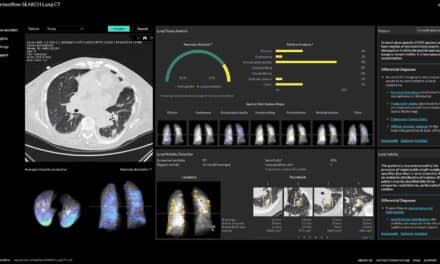By Chaunie Brusie
Karl Yaeger, 34, an MD with St. Luke’s University Health Network in Bethlehem, Pa., is a young doctor making a big impact. Currently involved in a collaborative project with GE Healthcare that is focused on exploring the use of artificial intelligence (AI) to detect pneumothorax at the time of image acquisition, Yaeger is looking forward to applying his research to the field—and positively impacting the patients the new technology will serve.
Early Interest in Technology
Yaeger tells AXIS Imaging News that he first became interested in radiology due to what he dubs the “incredible technology” and cerebral nature of the work. “I’ve always been interested in gadgets and technology, and radiology is certainly the most tech-heavy medical specialty,” he says.
Through a traditional educational pathway, Yaeger earned his bachelor of science degree from Penn State, followed immediately by medical school at the University of Pittsburgh. Because informatics always interested him, he added a minor in information sciences and technology and subsequently gained experience in medical informatics while in medical school and during his residency. And now he can apply that knowledge to his work with AI.
Yaeger calls his current research with GE “serendipitous,” noting that the company approached him due to the long-standing collaboration between St. Luke’s and GE. “It was a great fit, given my research background at Pittsburgh and my interest in technology and informatics,” he says, adding that the project also offered a promising pathway to improve patient care.
Although the system he is working on is not yet FDA-approved, he predicts that the biggest advantage of AI in this sphere will be the ability to provide initial image analysis on every case immediately and consistently. “In the current setting, the most promising aspect is saving lives by decreasing time to image interpretation and ultimate treatment of pneumothorax,” he says.
And as for AI as a whole in radiology, Yaeger anticipates that there will be three major areas of innovation (not necessarily sequential):
- An initial broadening of the conditions that AI can detect, as well as improved accuracy.
- A refining of the output of various AI systems and the presentation to the radiologist and ordering provider to optimize effectiveness and efficiency.
- Iterative learning at a large scale. “Millions of medical images are acquired annually, but they currently do not flow back to the developer to help improve AI algorithms,” he says. “Hopefully in the future, a framework can be established to allow every image to further improve machine learning and, thereby, benefit every future patient.”
Looking to the Future
Although the future undoubtedly holds a lot of exciting developments for Yaeger professionally, he is taking his work one step at a time and enjoying the process along the way. “At this point, I’m very early in my career,” he says. “Currently, I’m pleased that I joined a group that shares my values and has colleagues I enjoy working with.”
And as he looks forward to his career flourishing, Yaeger remains humble through it all—and thankful for the people in his corner. “This research has been an incredible opportunity, which has been more successful than I could have imagined,” he says. “That success would not have been possible without my colleagues, Drs. Fournier and Modi, my collaborators at GE, and the support of my family—[physician wife, Susan, and young children, Emmett and Juliana.]”
Chaunie Brusie is associate editor of AXIS Imaging News. Questions and comments can be directed to chief editor Keri Forsythe-Stephens to [email protected].

![Applying AI to Pneumothorax Detection [Radiology’s Most Influential]](https://axisimagingnews.com/wp-content/uploads/2019/07/Karl-Yaeger.jpg)




